Intel Details Manufacturing through 2023: 7nm, 7+, 7++, with Next Gen Packaging
by Ian Cutress & Anton Shilov on May 8, 2019 4:35 PM ESTAt Intel's Investor Day today, CEO Bob Swan and Murthy Renduchintala spoke to the ability of the company with respect to its manufacturing capabilities. Intel has historically been strong in its ability to execute on its process technology, however the delay of its 10nm process has obviously raised multiple question marks, and has done for several years. The two Intel executives went into a little detail about what Intel was doing in the interim, and how it has learned from the issues.
Back in 2013, Intel envisoned its 10nm to succeed the 14nm by providing 2.7x density, with new technologies such as Self-Aligned Quad Patterning (SAQP), Contact over Active Gate (COAG), Cobolt Interconnects, and new packaging technologies such as EMIB and Foveros. Intel admits that this was an ambitious plan, and the goals were not clearly defined with the teams and it was ultimately overly complex and not managed in an ideal way.
This ended up pushing 10nm out into a later time frame. In this case, Intel pushed 10nm out to 2019 (technically they shipped Cannon Lake in small quantities on 10nm in 2017, however that is nothing more than a curio in the timeline of semiconductors), and filled the gap with 14+ and 14++.
Intels 14+ and 14++ processes extracted more than 20% more performance (from Broadwell to Whiskey Lake) from the process since its inception. As a result, Intel is prepared to not only get ready for future intra-node optimizations, but actually adjust the roadmap to compensate for it. Murthy made it clear that Intel wants to introduce a Moore's Law-like gain at the beginning of a new process, and another similar gain by the end of the process.
Intel has stated that its 10nm product family (beyond Cannon Lake) will start to be available from the middle of this year (2019), with Ice Lake on client platforms (notebooks).
Intel will be launching multiple 10nm products through 2019 and 2020, including server based 10nm in the first half of 2020:
In the above slide, Intel states that it will have 7nm in production and launching a product in 2021. That sounds very aggressive for a company that has had issues with 10nm. It even shows in Intels radmap, with 10nm (and 10+ and 10++) having a much shorter life cycle than the 14nm family of processes.
With this in mind, Intel's 7nm is going to be the combination of what Intel has learned from the 14nm and 10nm family of products. Intel wants that 2x scaling (Moores Law), but with intra-node optimations planned as part of the roadmap. Intel is also reducing its number of design rules, which should help with execution. 7nm will also be where Intel intersects with EUV, and also introduce next-gen Foveros and EMIB packainging.
Intel provided this slide, which shows a monolithic PC-Centric die with a multi-die Data-Centric chip built on both Foveros and EMIB. This corroborates our discussion with Intel's chiplet and packaging team, who also stated that we would see Foveros and EMIB on a combined product - specifically the GPU.
Intel announced that its lead 7nm product (lead = top, or lead = first?) would be its new GPGPU, built on the Xe graphics architecture. Intel has stated that its Xe product stack will feature two different microarchitectures from mobile client up to GPGPU, with one of those architectures called Arctic Sound - technically Intel will launch its first discrete GPU in 2020 according to its press release, however the 7nm GPGPU will be launched in 2021.
More information is coming out of Intel's Event, more to follow.
Related Reading
- Intel: EUV-Enabled 7nm Process Tech is on Track
- Intel Starts Qualification of Ice Lake CPUs, Raises 10nm Volume Expectation for 2019
- Intel Agilex: 10nm FPGAs with PCIe 5.0, DDR5, and CXL
- Intel to Equip Fab 42 for 7 nm
- Intel Discloses Plans to Spend $5 Billion on Fab 28 Expansion in Israel
- Intel Submits Ireland Fab Expansion Plan: $8 Billion Price Tag, With a 4 Year Lead Time
- Intel Details Plans for Its Oregon Fab Expansion: D1X Phase 3
- Intel to Expand Production Capacities at Multiple Fabs
Source: Intel


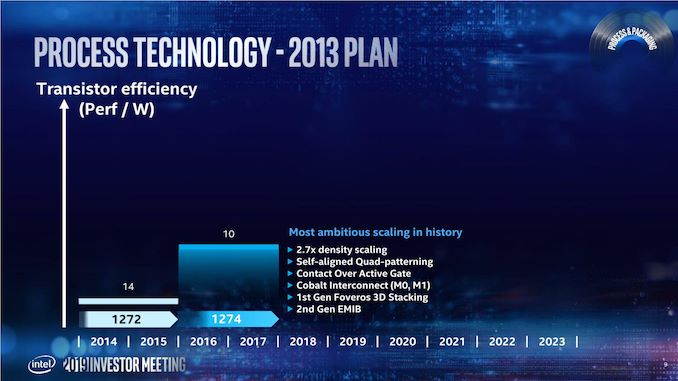

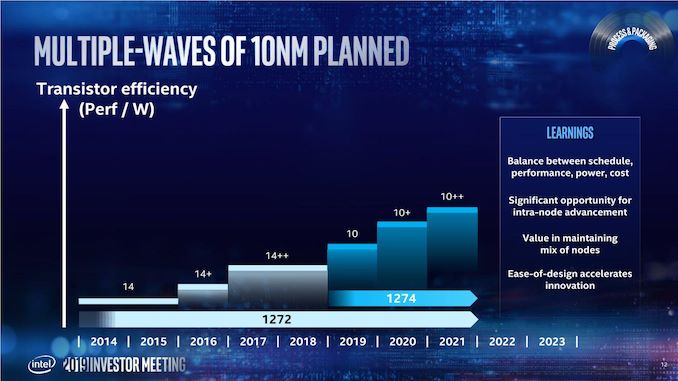
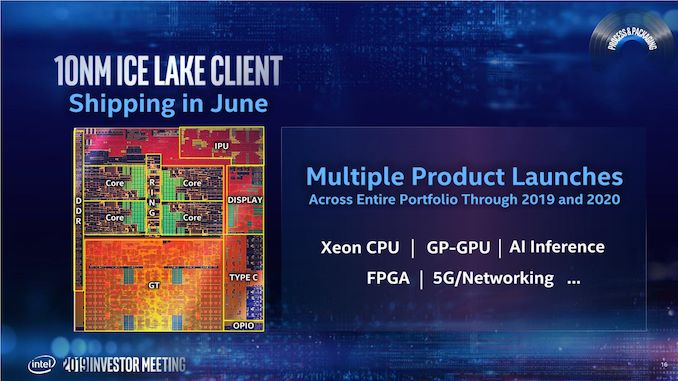
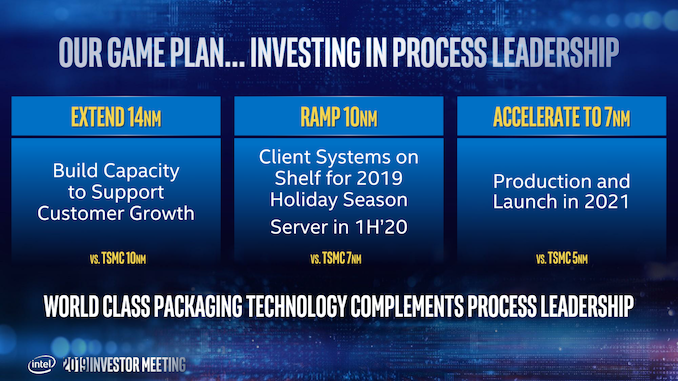
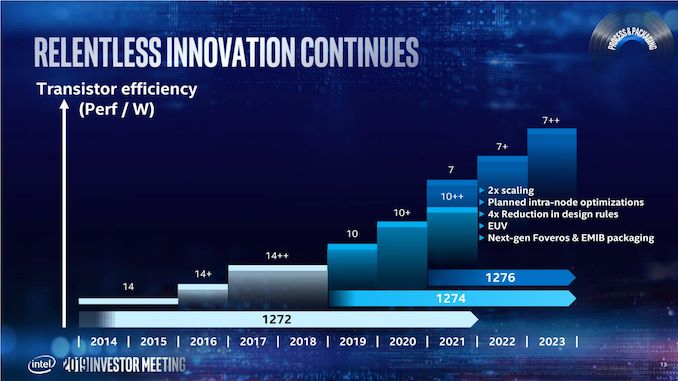

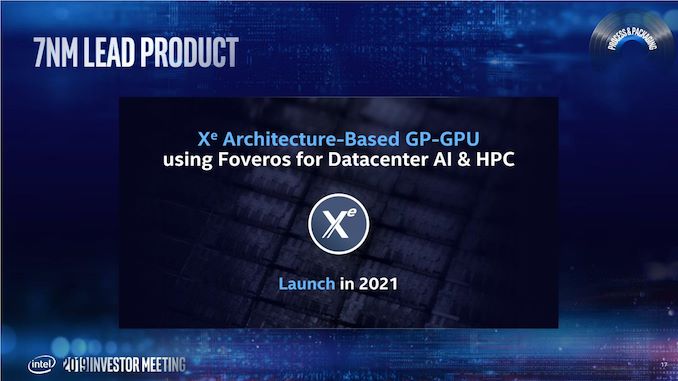








237 Comments
View All Comments
Manch - Thursday, May 9, 2019 - link
Just stop with the BS you shill. The lake names have been mentioned plenty in slides made available to the public. While the + &++ offered 10% improvement each time, the only reason we get 4Ghz & double the cores is bc Intel has to now compete with AMD since the release of Zen.Arbie - Thursday, May 9, 2019 - link
Trying to start a flame war? Your rudeness adds nothing to your position nor to the thread.Manch - Thursday, May 9, 2019 - link
Whatever. Every damn article this dude starts with the shilling. Its annoying as hell.Korguz - Thursday, May 9, 2019 - link
arbie, you obviously have NOT seen the various articles he has posted in.. each one of them is pro intel, .. most of it.. seems to be made up by him, or twisted to make intel look better then they are... take a look at the one about micron buying the fab from intel for 1.4 or 1.5 billion for example.... he is pretty much the intel fanboy poster child on hereHStewart - Thursday, May 9, 2019 - link
This is real information - with personal experience - my Y50 has 2.4Ghz quad core - while my 8th generation Dell XPS 15 2in1 goes up 4Ghz - both are down stairs and both are 14nm and quad cores. That is real informationTargon - Friday, May 10, 2019 - link
Real information only applies to true product releases. Anything that talks about the Intel release schedule more than two months in advance is really just repeating the general lies that Intel keeps putting out there to try to keep the stock price up.2015: 10nm is on track
2016: 10nm is on track
2017: 10nm is on track
2018: We have 10nm products(dual core laptop chips which no one has actually seen)
2019: We will have 10nm products this year(low volume laptop chips MAYBE, might be real, might show up in November/December in products).
Since we can't build our own laptops, even if Intel was shipping to OEMs on the day of the launch, it would take six months before those products would get into the hands of consumers. Intel won't have high end 10nm desktop parts out before 2021, so there won't be much improvement over the 9900k for at least another year and a half.
Targon - Friday, May 10, 2019 - link
When a company makes promises for four years and doesn't deliver, and new products are not seen as terribly innovative or a big step forward, that DOES tend to make people not believe anything that company has to say. The biggest jump for Intel was the 8 core consumer chips, but they do run hot and require a lot of power, plus the TDP rating is misleading to say the least.If Intel ever starts to deliver on its promises again, people might go back to paying attention. Right now, 10nm, for all the potential, may not deliver better performance compared to 14nm+++++. Laptop chips won't show up in products for 3-6 months after they come out as well, so by that time, any excitement would probably be gone.
The other thing, and many people keep missing this, is that new fab process with theoretical improvements mean nothing to consumers if these things do not result in improvements that people care about. New fab process...does it improve base/boost/turbo speeds? Does it lower power demand in a way that will help(lower CPU power but then putting a 4k power hungry screen into a laptop won't help most people). Does battery life really matter to most people if they leave their laptop plugged in all the time?
That is why EUV means nothing for users, because by itself it won't actually improve CPU performance or lower power draw or anything like that. It is important in the long run, but if it doesn't provide any true benefits to those using computers, then no one should get worked up about it.
wiyosaya - Wednesday, May 8, 2019 - link
Ah poor Intel. It must be tough to be on the defensive these days.imaheadcase - Wednesday, May 8, 2019 - link
Yah a company working towards goals it already wanted. So defensive.HStewart - Wednesday, May 8, 2019 - link
This is not defensive - this is offensive attack. But keep in mind this is only one part of this - what is not stated here is the 2h ":Shipping in June" which is technically still Q2 is not only machines with 10nm (Not to be confused with Cannon Lake) but an entirely new architexture called Sunny Cove.To me, Sunny Cove has possibility of being not evolutionary but revolutionary in design. It just technical hunch but I see the new addition of second store unit a major revolution coming. What makes it so exiting is that it is addition to dual loads and existing store unit - but they separated load/store and other load/store units - this means they can run parallel load/store operations in the same clock cycle. To me this is hidden jewel inside the chip but this could be not as great as I believe.
I would not doubt there is other parts of Sunny Cove that also have significant changes to effect performance. So one thing to keep in mind - June is not just 10nm process coming but also that a new architexture is coming. It Intel's terms this means June release will be Tick and Tock together. This could be extremely important. Intel is not stupid and they are not sitting around while AMD and ARM are challenging them from both sides.